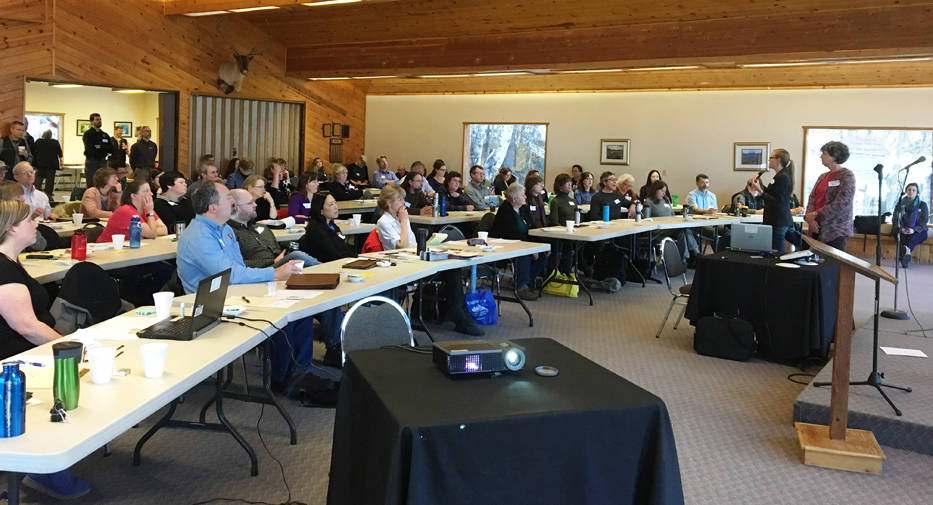If you’re a Kenai Peninsula resident, here are some important events that I’m guessing you don’t know. Do you know that management of public lands on more than half of our 6-million-acre peninsula is currently being updated? Chugach National Forest is in the middle of revising its Forest Plan. The Alaska Department of Fish and Game is revising its management plan for Kachemak Bay and Fox River Flats Critical Habitat Areas. The draft revised management plan for Kachemak Bay State Park and State Wilderness Park is expected to be out for public review on April 24th.
Closer to home for many of you, the revision process for the Kenai Peninsula Borough Comprehensive Plan is just getting started. And did you know that there has never been a land management plan for the 130,000 acres owned by the Borough? That, too, is scheduled to begin development in the near future.
Only 4 percent of the Kenai Peninsula is in private ownership, carved into over 55,000 parcels. Another 8 percent is owned by Native villages and corporations. So you should hope (and expect as a citizen) that the various agencies are doing their best to manage the 88 percent of the peninsula that is held in the public trust.
All of this and much more was discussed this past week at a workshop entitled “Land Management on the Kenai Peninsula: Opportunities to Work Across Boundaries”. Over 80 representatives from federal, state and local land management agencies, Native corporations and villages, and partnerships met at the Solid Rock Bible Camp to share information and discuss ways of doing business better. Mayor Mike Navarre opened the workshop by sharing his perspective on planning processes that had gone well…and others not so well.
But there are some landscape-scale issues that simply know no boundaries, and this is the role that interagency and citizen-driven partnerships fill. The All Lands – All Hands partnership strategically places fuel breaks around communities to help stop wildfires that might not otherwise stop when they burn to the boundaries of the Kenai National Wildlife Refuge. The Kenai Peninsula Fish Habitat Partnership works to protect, maintain, restore and enhance fish habitat wherever it may occur, helped by the Partners for Fish &Wildlife Program and the National Fish Passage Program. Interagency partners in the Kenai Peninsula Cooperative Weed Management Area work as a team to eradicate and contain invasive plant species.
The Kenai Mountains to Sea partnership seeks to sustain riparian corridors along 20 streams that comprise half of the 1,800 miles of anadromous waters on the peninsula. These 20 streams are “interjurisdictional”, meaning that their headwaters are protected within the Federal conservation units but they flow through what is sometimes a gauntlet of private lands to get to the sea.
An advisory board composed of agency representatives, user groups, and citizens helps State Parks manage the Kenai River Special Management Area. The Stream Watch Volunteer Program, jointly administered by Chugach National Forest and Kenai Watershed Forum, works over multiple jurisdictions to help educate the public, enforce rules, and clean up the Kenai River.
A nonprofit organization is working to promote bike trails between trailheads along the Seward and Hope Highways as a way of appreciating the Kenai Mountains-Turnagain Arm National Heritage Area. The Friends of Kachemak Bay State Park is developing the Kachemak Bay Water Trail so kayakers (and other boaters) can circumnavigate the multi-jurisdictional shoreline of Kachemak Bay.
There were some cross-boundary issues that still need champions. Consider our current need for a more strategic view on future development of the peninsula’s road network. Consider our rapidly evolving need to begin planned adaptation to a warming climate.
If you don’t know about some of these management plans for public lands or partnerships, you’re not alone. There were more than a few professionals at this forum who were surprised at how much really is going on. One idea floated was to maintain a website where all plans and projects could be posted.
Another idea was to create a library of available spatial data, perhaps called the Kenai GeoHub, where links to (or contacts for) important data sets for the Kenai Peninsula could be maintained. Along those same lines, it was agreed that a second workshop would be held this fall to discuss data needs common to all or most land management agencies and organizations.
Perhaps the most important outcome was the general agreement that a gathering similar to what occurred this past week should happen annually. This kind of collegial networking and information sharing is critical to create and sustain truly collaborative efforts among public agencies. Frankly, we’ll need to pool our resources and work smarter as local, state and federal budget forecasts seem slim over the next few years.
Lastly, I encourage you to engage in the public process for managing lands that all of us own!
Dr. John Morton is the supervisory biologist at Kenai National Wildlife Refuge. Find more information about the Refuge athttp://www.fws.gov/refuge/kenai/ or http://www.facebook.com/kenainationalwildliferefuge.

